Fujitsu E8310 User Manual

Fujitsu LifeBook®
E8310 Notebook
User’s Guide
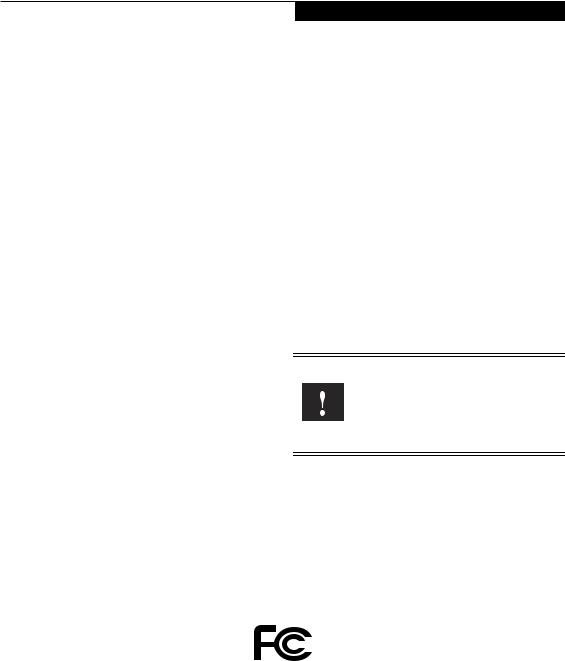
C o p y r i g h t
Copyright and Trademark Information
Fujitsu Computer Systems Corporation has made every effort to ensure the accuracy and completeness of this document; however, as ongoing development efforts are continually improving the capabilities of our products, we cannot guarantee the accuracy of the contents of this document. We disclaim liability for errors, omissions, or future changes.
Fujitsu, the Fujitsu logo, and LifeBook are registered trademarks of Fujitsu Limited.
Intel, Intel Core, Centrino, and Intel Centrino Pro are trademarks or registered trademarks of Intel Corporation or its subsidiaries in the United States and other countries.
Microsoft, Windows, and Windows Vista are either registered trademarks or trademarks of Microsoft Corporation in the United States and/or other countries.
The ExpressCard word mark and logo are owned by the Personal Computer Memory Card International Association (PCMCIA) and any use of such marks by Fujitsu Computer Systems Corporation is under license.
PCMCIA is a trademark of the Personal Computer Memory Card International Association.
Bluetooth is a trademark of Bluetooth SIG, Inc., USA.
OmniPass is a trademark of Softex, Inc.
Atheros and Super AG are registered trademarks of Atheros Communications, Inc.
Roxio is a trademark of Roxio, a division of Sonic Solutions.
Adobe, Acrobat, and Acrobat Reader are either a registered trademarks or trademarks of Adobe Systems Inc. in the United States and/or other countries.
Norton and Norton Internet Security are trademarks or registered trademarks of Symantec Corporation in the United States and other countries.
PowerProducer is a trademark of CyberLink Corp.
The DVD player found in some models of the LifeBook notebook incorporates copyright protection technology that is protected by method claims of certain U.S. patents and other intellectual property rights owned by Macrovision Corporation and other rights users. Use of this copyright protection technology must be authorized by Macrovision Corporation, and is intended for home and other limited viewing uses only unless authorized by Macrovision Corporation. Reverse engineering or disassembly is prohibited.
All other trademarks mentioned herein are the property of their respective owners.
Warning
Handling the cord on this product will expose you to lead, a chemical known to the State of California to cause birth defects or other reproductive harm.
Wash hands after handling.
© Copyright 2007 Fujitsu Computer Systems Corporation. All rights reserved.
No part of this publication may be copied, reproduced, or translated, without prior written consent of Fujitsu. No part of this publication may be stored or transmitted in any electronic form without the written consent of Fujitsu. B5FJ-3971-01EN-00
DECLARATION OF CONFORMITY according to FCC Part 15
Responsible Party Name: |
Fujitsu Computer Systems Corporation |
Address: |
1250 E. Arques Avenue, M/S 122 |
|
Sunnyvale, CA 94085 |
Telephone: |
(408) 746-6000 |
Declares that product: |
Base Model Configuration: |
|
LifeBook E8310 notebook |
|
Complies with Part 15 of the FCC Rules. |
This device complies with Part 15 of the FCC rules. Operations are subject to the following two conditions:
(1) This device may not cause harmful interference, (2) This device must accept any interference received, including interference that may cause undesired operation.
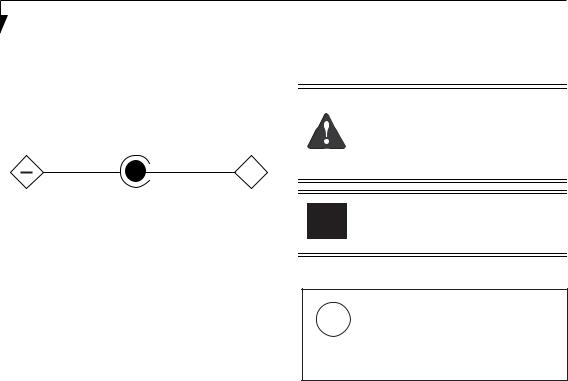
L i f e B o o k E 8 0 0 0 N o t e b o o k
IMPORTANT SAFETY INSTRUCTIONS
This unit requires an AC adapter to operate. Use only UL Listed Class II Adapters with an output rating of 19 VDC, with a current of 5.27 A (100W).
AC adapter output polarity:
+
When using your notebook equipment, basic safety precautions should always be followed to reduce the risk of fire, electric shock and injury to persons, including the following:
■Do not use this product near water for example, near a bathtub, washbowl, kitchen sink or laundry tub, in a wet basement or near a swimming pool.
■Avoid using the modem during an electrical storm. There may be a remote risk of electric shock from lightning.
■Do not use the modem to report a gas leak in the vicinity of the leak.
■Use only the power cord and batteries indicated in this manual. Do not dispose of batteries in a fire. They may explode. Check with local codes for possible special disposal instructions.
■To reduce the risk of fire, use only No. 26 AWG or larger UL Listed or CSA Certified Telecommunication Line Cord.
For TV tuner use: To protect from overvoltages and transients on the Cable Distribution System, make sure that the outer shield of the coaxial cable is connected to earth (grounded) at the building premise as close to the point of cable entrance as practicable, as required per NEC Article 820.93, ANSI/NFPA 70: 2005. If you have questions about your CATV installation, contact your service provider.
SAVE THESE INSTRUCTIONS
For Authorized Repair Technicians Only
Danger of explosion if Lithium (clock) battery is incorrectly replaced. Replace only with the same or equivalent type recommended by the manufacturer. Dispose of used batteries according to the manufacturer’s instruction.
For continued protection against risk of fire, replace only with the same type and rating fuse.
System Disposal
LAMP(S) INSIDE THIS PRODUCT Hg CONTAIN MERCURY AND MUST BE RECYCLED OR DISPOSED OF
ACCORDING TO LOCAL, STATE, OR FEDERAL LAWS.

T a b l e o f C o n t e n t s
Fujitsu LifeBook® E8310 Notebook
Table of Contents
1
PREFACE
Conventions Used in the Guide . . . . . . . . . . . . . . 1
Fujitsu Contact Information . . . . . . . . . . . . . . . . . 1
Limited Warranty . . . . . . . . . . . . . . . . . . . . . . . . . 1
2
GETTING TO KNOW
YOUR LIFEBOOK NOTEBOOK
Overview
Unpacking . . . . . . . . . . . . . . . . . . . . . . . . . . . . . . 5
Locating the Controls/Connectors
Top Components . . . . . . . . . . . . . . . . . . . . . . . . . 6
Left-Side Panel Components . . . . . . . . . . . . . . . . 8
Right-Side Panel Components . . . . . . . . . . . . . . . 9
Back Panel Components . . . . . . . . . . . . . . . . . . . 10
Bottom Components . . . . . . . . . . . . . . . . . . . . . 11
Status Indicator Panel
Power Indicator . . . . . . . . . . . . . . . . . . . . . . . . . 12
AC Adapter Indicator . . . . . . . . . . . . . . . . . . . . . 12
Battery Level Indicators . . . . . . . . . . . . . . . . . . .12
Battery Charging Indicators . . . . . . . . . . . . . . . . 13
WLAN Access Power Indicator . . . . . . . . . . . . . . 13
Optical Drive Access Indicator . . . . . . . . . . . . . . 13
Hard Drive Access Indicator . . . . . . . . . . . . . . . . 13
PC Card Access Indicator . . . . . . . . . . . . . . . . . . 13
NumLk Indicator. . . . . . . . . . . . . . . . . . . . . . . . . 13
CapsLock Indicator . . . . . . . . . . . . . . . . . . . . . . . 13
ScrLk Indicator . . . . . . . . . . . . . . . . . . . . . . . . . . 13
Security Indicator . . . . . . . . . . . . . . . . . . . . . . . . 13
Keyboard
Using the Keyboard . . . . . . . . . . . . . . . . . . . . . . 14
Numeric Keypad. . . . . . . . . . . . . . . . . . . . . . . . . 14
Windows Keys . . . . . . . . . . . . . . . . . . . . . . . . . . 14
Cursor Keys . . . . . . . . . . . . . . . . . . . . . . . . . . . . 14
Function Keys. . . . . . . . . . . . . . . . . . . . . . . . . . . 15
Touchpad Pointing Device
Clicking . . . . . . . . . . . . . . . . . . . . . . . . . . . . . . .16
Double-Clicking . . . . . . . . . . . . . . . . . . . . . . . . .16
Dragging . . . . . . . . . . . . . . . . . . . . . . . . . . . . . .17
Touchpad Control Adjustment . . . . . . . . . . . . . .17
Scrolling . . . . . . . . . . . . . . . . . . . . . . . . . . . . . . .17
Optional Quick Point Feature . . . . . . . . . . . . . . .17
Volume Control
Controlling the Volume . . . . . . . . . . . . . . . . . . .18
Flexible Bay Devices
Removing and Installing Modular Devices . . . . .19
LifeBook Security/Application Panel
Setting up Your LifeBook Security Panel . . . . . . .20 Passwords . . . . . . . . . . . . . . . . . . . . . . . . . . . . .20 Operating Your Security/Application Panel. . . . .21 Uninstalling the Security Panel Application . . . . .21 Launching Applications with the Panel . . . . . . . .22
3
GETTING STARTED
Power Sources
Connecting the Power Adapters . . . . . . . . . . . . .27
Display Panel
Opening the Display Panel . . . . . . . . . . . . . . . . .28
Adjusting Display Panel Brightness . . . . . . . . . . .28
Closing the Display Panel . . . . . . . . . . . . . . . . . .28
Starting Your LifeBook Notebook
Power On. . . . . . . . . . . . . . . . . . . . . . . . . . . . . .29 Boot Sequence . . . . . . . . . . . . . . . . . . . . . . . . . .29 Hard Disk Drive Passwords . . . . . . . . . . . . . . . . .29 BIOS Setup Utility. . . . . . . . . . . . . . . . . . . . . . . .29 Booting the System . . . . . . . . . . . . . . . . . . . . . .30 Starting Windows Vista the first time . . . . . . . . .30 Starting Windows XP the First Time . . . . . . . . . .31 Registering Your LifeBook notebook. . . . . . . . . .31 Installing Click Me! . . . . . . . . . . . . . . . . . . . . . .31 Fujitsu Driver Update Utility . . . . . . . . . . . . . . . .31

L i f e B o o k E 8 0 0 0 N o t e b o o k
Power Management
Power/Suspend/Resume Button. . . . . . . . . . . . . 32
Standby Mode . . . . . . . . . . . . . . . . . . . . . . . . . . 32
Hibernation (Save-to-Disk) Feature . . . . . . . . . . 32
Windows Power Management . . . . . . . . . . . . . . 33
Restarting the System. . . . . . . . . . . . . . . . . . . . . 33
Powering Off . . . . . . . . . . . . . . . . . . . . . . . . . . . 33
4
USER-INSTALLABLE FEATURES
Lithium ion Battery
Recharging the Batteries. . . . . . . . . . . . . . . . . . . 37 Replacing the Battery . . . . . . . . . . . . . . . . . . . . . 38
Optical Drive
Media Player Software . . . . . . . . . . . . . . . . . . . . 39 Loading Media on Your Drive . . . . . . . . . . . . . . 39 Removing Media . . . . . . . . . . . . . . . . . . . . . . . . 40 Emergency Optical Drive Tray Release . . . . . . . . 40 Using the Media Player Software . . . . . . . . . . . . 40
Memory Stick/Secure Digital Cards
Installing Memory Stick/SD Cards . . . . . . . . . . . 41
Removing A Memory Stick/SD Card . . . . . . . . . 41
PC Cards/ExpressCards™
Inserting PC Cards . . . . . . . . . . . . . . . . . . . . . . . 42
Removing PC Cards . . . . . . . . . . . . . . . . . . . . . . 42
Inserting ExpressCards . . . . . . . . . . . . . . . . . . . . 43
Removing ExpressCards . . . . . . . . . . . . . . . . . . . 43
Smart Card Reader. . . . . . . . . . . . . . . . . . . . . . . 43
Memory Upgrade Module
Installing Memory Upgrade Modules . . . . . . . . . 44
Removing a Memory Upgrade Module . . . . . . . 44
Checking the Memory Capacity . . . . . . . . . . . . . 45
Device Ports
Modem (RJ-11) Telephone Jack . . . . . . . . . . . . . 46
Internal LAN (RJ-45) Jack . . . . . . . . . . . . . . . . . . 46
Parallel Port . . . . . . . . . . . . . . . . . . . . . . . . . . . . 46
Serial Port. . . . . . . . . . . . . . . . . . . . . . . . . . . . . . 47
Port Replicator Connector . . . . . . . . . . . . . . . . . 47
Universal Serial Bus Ports . . . . . . . . . . . . . . . . . . 47
Infrared Port. . . . . . . . . . . . . . . . . . . . . . . . . . . . 47
Headphone Jack. . . . . . . . . . . . . . . . . . . . . . . . . 47
Microphone Jack . . . . . . . . . . . . . . . . . . . . . . . . 48
External Video Port . . . . . . . . . . . . . . . . . . . . . . 48
5
TROUBLESHOOTING
Identifying the Problem . . . . . . . . . . . . . . . . . . . 51
Specific Problems . . . . . . . . . . . . . . . . . . . . . . . . 51
Troubleshooting Table . . . . . . . . . . . . . . . . . . . . 52
Power On Self Test Messages . . . . . . . . . . . . . . 59
Emergency Media Player Drive Tray Release . . . 60
Modem Result Codes. . . . . . . . . . . . . . . . . . . . . 60
Restoring Your Pre-installed Software . . . . . . . . 61
Restoring the Factory Image . . . . . . . . . . . . . . . 61
Automatically Downloading Driver Updates. . . . 62
6
CARE AND MAINTENANCE
Batteries. . . . . . . . . . . . . . . . . . . . . . . . . . . . . . . 66
Floppy Disks and Drives . . . . . . . . . . . . . . . . . . . 66
Media Care . . . . . . . . . . . . . . . . . . . . . . . . . . . . 67
PC Cards/ExpressCards . . . . . . . . . . . . . . . . . . . 67
7
SYSTEM SPECIFICATIONS
Configuration Label . . . . . . . . . . . . . . . . . . . . . . 71
Microprocessor . . . . . . . . . . . . . . . . . . . . . . . . . 71
Chipset . . . . . . . . . . . . . . . . . . . . . . . . . . . . . . . 71
Memory. . . . . . . . . . . . . . . . . . . . . . . . . . . . . . . 71
Video. . . . . . . . . . . . . . . . . . . . . . . . . . . . . . . . . 71
Audio. . . . . . . . . . . . . . . . . . . . . . . . . . . . . . . . . 71
Mass Storage Device Options . . . . . . . . . . . . . . 71
Features. . . . . . . . . . . . . . . . . . . . . . . . . . . . . . . 72
Device Ports. . . . . . . . . . . . . . . . . . . . . . . . . . . . 72
Keyboard . . . . . . . . . . . . . . . . . . . . . . . . . . . . . . 72
Power . . . . . . . . . . . . . . . . . . . . . . . . . . . . . . . . 72
Dimensions and Weight. . . . . . . . . . . . . . . . . . . 72
Environmental Requirements . . . . . . . . . . . . . . . 73
Popular Accessories . . . . . . . . . . . . . . . . . . . . . . 73
Pre-Installed Software . . . . . . . . . . . . . . . . . . . . 73
8
GLOSSARY/REGULATORY
Glossary. . . . . . . . . . . . . . . . . . . . . . . . . . . . . . . 77
Regulatory Information . . . . . . . . . . . . . . . . . . . 83

T a b l e o f C o n t e n t s
APPENDIX A: INTEGRATED
WIRELESS LAN USER’S GUIDE
Before Using the Wireless LAN
Wireless LAN Modes Using this Device. . . . . . . . 88
Wireless Network Considerations . . . . . . . . . . . . 89
Deactivating the WLAN Device . . . . . . . . . . . . . 89
Activating the WLAN Device . . . . . . . . . . . . . . . 90
Configuration of the WLAN Device
Configuring the WLAN with Windows Vista. . . . 91
Connecting to a Network with Windows Vista . . 91
Configuring the WLAN Using Windows XP . . . . 91
Connection to the Network . . . . . . . . . . . . . . . . 94
Troubleshooting the WLAN
Troubleshooting . . . . . . . . . . . . . . . . . . . . . . . . . 97
WLAN Specifications
Specifications . . . . . . . . . . . . . . . . . . . . . . . . . . . 98
Using the Bluetooth Device
What is Bluetooth. . . . . . . . . . . . . . . . . . . . . . . . 99
Where to Find Information About Bluetooth . . . 99
APPENDIX B: USING THE
FINGERPRINT SENSOR
Fingerprint Sensor Device
Introducing the Fingerprint Sensor Device . . . .103
Getting Started. . . . . . . . . . . . . . . . . . . . . . . . . 103
Installing OmniPass . . . . . . . . . . . . . . . . . . . . . 103
User Enrollment . . . . . . . . . . . . . . . . . . . . . . . . 104
Using OmniPass . . . . . . . . . . . . . . . . . . . . . . . . 105
Configuring OmniPass . . . . . . . . . . . . . . . . . . . 107
OmniPass Control Center . . . . . . . . . . . . . . . . . 108
Troubleshooting . . . . . . . . . . . . . . . . . . . . . . . . 109
Index
Index . . . . . . . . . . . . . . . . . . . . . . . . . . . . . . . . 111

L i f e B o o k E 8 0 0 0 N o t e b o o k

1
Preface

L i f e B o o k E 8 0 0 0 N o t e b o o k

Preface
ABOUT THIS GUIDE
The LifeBook E8310 notebook from Fujitsu Computer Systems Corporation provides desktop performance with a fast, Intel® Core™ 2 Duo processor. Depending upon the configuration, your notebook has either a built-in 15.4” TFT XGA or SXGA+ color display. This system brings the computing power of desktop personal computers (PCs) to a portable environment.
Your computer comes with Microsoft Windows® XP Professional or Windows Vista Business operating system pre-installed.
This manual explains how to operate your LifeBook notebook’s hardware and built-in system software.
CONVENTIONS USED IN THE GUIDE
Keyboard keys appear in brackets.
Example: [Fn], [F1], [ESC], [ENTER] and [CTRL].
Pages with additional information about a specific topic are cross-referenced within the text.
For example: (See page xx.)
On screen buttons or menu items appear in bold Example: Click OK to restart your LifeBook notebook.
The information icon highlights information that will enhance your understanding of the subject material.
The caution icon highlights information that is important to the safe operation of your computer, or to the integrity of your files. Please read all caution information carefully.
The warning icon highlights information that can be hazardous to either you, your LifeBook notebook, or your files. Please read all warning information carefully.
P r e f a c e
FUJITSU CONTACT INFORMATION
Service and Support
You can contact Fujitsu Service and Support in the following ways:
■Toll free: 1-800-8Fujitsu (1-800-838-5487)
■E-mail: 8fujitsu@us.fujitsu.com
■Website: us.fujitsu.com/computers
Before you place the call, you should have the following information ready so that the customer support representative can provide you with the fastest possible solution:
■Product name
■Product configuration number
■Product serial number
■Purchase date
■Conditions under which the problem occurred
■Any error messages that have occurred
■Type of device connected, if any
Fujitsu Shopping Online
You can go directly online to the Fujitsu Product catalog for your LifeBook notebook by going to the website at www.shopfujitsu.com.
You can also reach Fujitsu Service and Support online by clicking on Start -> Fujitsu Weblinks -> Fujitsu Service and Support.
You must have an active internet connection to use the online URL links.
LIMITED WARRANTY
Your LifeBook notebook is backed by a Fujitsu International Limited Warranty. Check the service kit that came with your notebook for the Limited Warranty period and terms and conditions.
1

L i f e B o o k E 8 0 0 0 N o t e b o o k
2

2
Getting to Know
Your LifeBook Notebook
3

L i f e B o o k E 8 0 0 0 N o t e b o o k
4
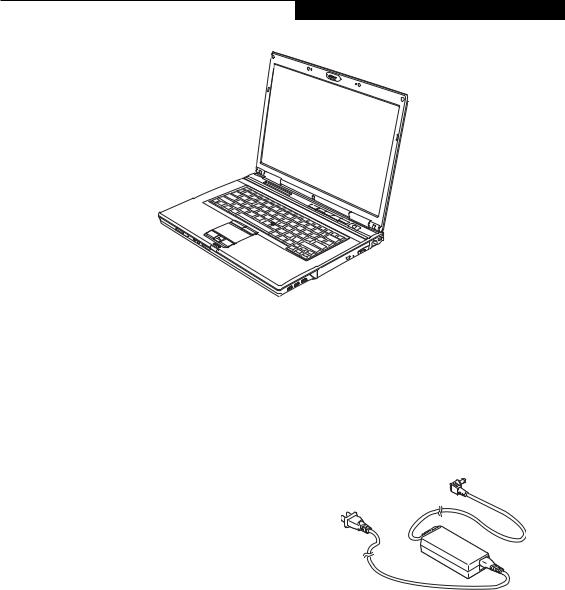
G e t t i n g t o K n o w Y o u r L i f e B o o k
Figure 2-1. Fujitsu LifeBook E8310 notebook
Overview
This section describes the components of your Fujitsu LifeBook E8310 notebook. We strongly recommend that you read it before using your notebook – even if you are already familiar with notebook computers.
UNPACKING
When you receive your LifeBook notebook, unpack it carefully, and compare the parts you have received with the items listed below.
For a pre-configured model you should have:
■LifeBook E8310 notebook (Figure 2-1)
■AC adapter with AC power cord (Figure 2-2)
■Lithium ion Battery, pre-installed
■Weight Saver
■Phone/Modem (RJ-11) telephone cable
■Driver and Application Restore (DAR) Disc
■Recovery DVD
■Getting Started Guide
■User’s Guide (this document)
■International Limited Warranty Brochure
■Microsoft®-associated product materials
Depending on your system configuration, one of the following devices will be pre-installed in the Flexible Bay:
■Weight Saver
■Modular Dual-Layer Multi-Format DVD Writer
■Modular DVD/CD-RW combo drive
■Modular DVD-ROM drive
Depending on your system configuration, the following optional items may be included with your system:
■Modular 2nd bay battery
■External USB floppy disk drive
■Application CDs for third-party software
Once you have checked and confirmed that your LifeBook system is complete, read through the following pages to learn about all of your notebook’s components.
Figure 2-2 AC Adapter
5
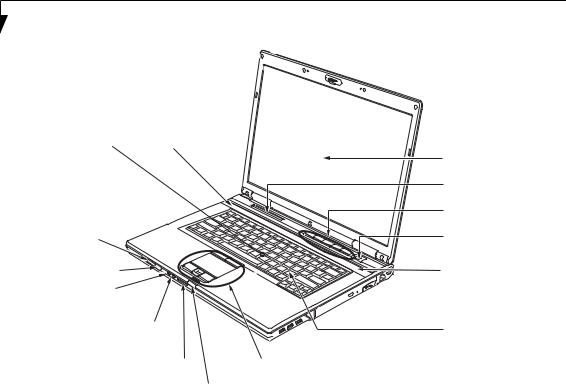
L i f e B o o k E 8 0 0 0 N o t e b o o k
Quick Point
Cursor Control (optional) Stereo Speaker
|
|
Display Panel |
|
|
Status Indicator Panel |
|
|
LifeBook Security/ |
Wireless LAN/Bluetooth |
|
Application Panel |
|
|
|
On/Off Switch |
|
Power/Suspend/ |
|
|
Resume Button |
Infrared (IrDA) Sensor |
|
Stereo Speaker |
Headphone/Optical |
|
|
Digital Audio Out Jack |
|
|
Microphone Jack |
|
Keyboard |
Memory Stick/SD Card Slot |
Touchpad Pointing Device |
|
|
|
|
Display Panel Latch Button |
|
|
Figure 2-3. LifeBook notebook with display open |
|
|
Locating the Controls
and Connectors
TOP COMPONENTS
The following is a brief description of your LifeBook notebook’s top components.
Display Panel
The display panel is a color LCD panel with back lighting for the display of text and graphics.
Status Indicator Panel
The Status Indicator Panel displays symbols that correspond with a specific component of your LifeBook notebook. (See Status Indicator Panel on page 12 for more information)
LifeBook Security/Application Panel
The LifeBook Security/Application Panel provides hardware security and one-touch application launch capability. (See LifeBook Security/Application Panel on page 20 for more information)
Power/Suspend/Resume Button
The Power/Suspend/Resume button allows you to suspend notebook activity without powering off, resume your notebook from standby mode, and power on your notebook when it has been shut down from Windows.
(See Power/Suspend/Resume Button on page 29 for more information)
Stereo Speakers
The built-in dual speakers allow for stereo sound.
Keyboard
A full-size keyboard with dedicated Windows keys. (See Keyboard on page 14 for more information)
Touchpad Pointing Device
The Touchpad pointing device is a mouse-like cursor control with five buttons: two right mouse-like buttons, two left mouse-like buttons, and a scroll button. The upper left and right buttons are for use with the Quick Point cursor control. (See Touchpad Pointing Device on page 16 for more information) Depending upon the configuration of your system, the scroll button may be configured as a fingerprint sensor device. (See Fingerprint Sensor Device on page 103 for more information)
Display Panel Latch Button
The display panel latch button is used to latch and unlatch the display. (See Opening the Display Panel on page 28 for more information)
Memory Stick/SD Card Slot
The Memory Stick/SD card slot allows you to install a Memory Stick or a Secure Digital (SD) card for data storage. This architecture allows you to transfer data
6

from a variety of different digital devices. (See Installing Memory Stick/SD Cards on page 41 for more information)
Microphone Jack
The microphone jack allows you to connect an external mono microphone.
Headphone Jack
The headphone jack allows you to connect headphones to listen to audio files.
Infrared (IrDA) Sensor
Provides an infrared interface for communication with devices IrDA Standard Rev.1.1-compliant.
G e t t i n g t o K n o w Y o u r L i f e B o o k
Wireless LAN/Bluetooth On/Off Switch
The wireless LAN/Bluetooth on/off switch is used to turn on and off the optional WLAN and Bluetooth devices. Switching the device off when not in use will help to extend battery life. (See Activating the WLAN Device on page 90 for more information)
Quick Point Cursor Control
The optional Quick Point control offers an additional method for moving the cursor. (See Optional Quick Point Feature on page 17 for more information)
7
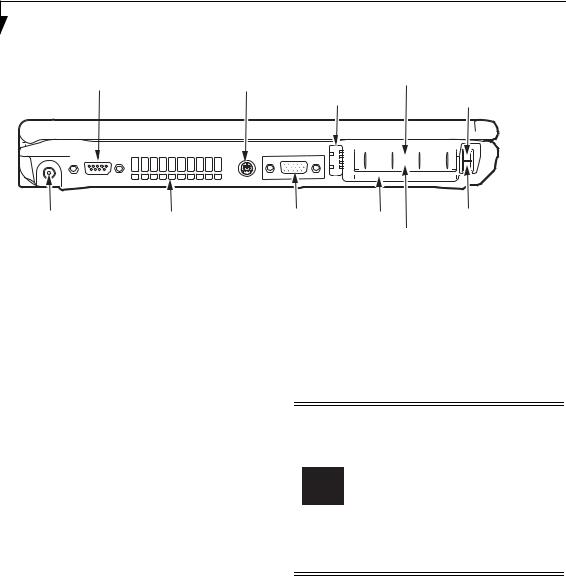
L i f e B o o k E 8 0 0 0 N o t e b o o k
|
|
|
|
Serial Port (behind cover) |
S-Video Out Port |
|
|
|
|
|
|
|
ExpressCard Slot (top slot) |
||||||||||||||||||||||
|
|
|
|
|
|
|
|
|
|
|
|
|
|
USB 2.0 Port |
ExpressCard Eject Button |
||||||||||||||||||||
|
|
|
|
|
|
|
|
|
|
|
|
|
|
|
|
|
|
|
|
|
|
|
|
|
|
|
|
|
|
|
|
|
|
|
|
|
|
|
|
|
|
|
|
|
|
|
|
|
|
|
|
|
|
|
|
|
|
|
|
|
|
|
|
|
|
|
|
|
|
|
|
|
|
|
|
|
|
|
|
|
|
|
|
|
|
|
|
|
|
|
|
|
|
|
|
|
|
|
|
|
|
|
|
|
|
|
|
|
|
|
|
|
|
|
|
|
|
|
|
|
|
|
|
|
|
|
|
|
|
|
|
|
|
|
|
|
|
|
|
|
|
|
|
DC Power Jack Air Vents External Video Smart Card Slot PC Card Eject Button
Port (behind cover)
PC Card Slot (bottom slot)
Figure 2-4. LifeBook notebook left-side panel
LEFT-SIDE PANEL COMPONENTS
The following is a brief description of your LifeBook notebook’s left-side components.
Serial Port
The serial port allows you to connect serial RS-232 devices, such as serial printers or serial scanners. (See Serial Port on page 48 for more information)
S-Video Out Port
The S-Video output is used to transmit a higher resolution video signal to a compatible TV or VCR.
USB 2.0 Ports
The USB 2.0 ports allow you to connect Universal Serial Bus devices. USB 2.0 transfers data at up to 480 Mbps and is backward-compatible with USB 1.1 devices, which transfer data at up to 12 Mbps. (See Universal Serial Bus Ports on page 47 for more information)
ExpressCard Slot/Eject Button
The ExpressCard slot allows you to install an ExpressCard. (See PC Cards/ExpressCards™ on page 42 for more information) The ExpressCard eject button is used for removing an ExpressCard from the slot.
PC Card Slot/Eject Button
The PC Card slot is for installing a Type I or Type II PC Card. (See PC Cards/ExpressCards™ on page 42 for more information) The PC Card eject button is used for removing a PC Card from the slot.
Smart Card Slot
A dedicated Smart Card slot is provided on your notebook. Smart Cards are the same size and shape as credit cards, but they contain an integrated microprocessor chip. (See Smart Card Reader on page 43 for more information) In order to use the embedded Smart Card Reader, you must purchase optional third-party software for installation.
External Video Port
The external monitor port allows you to connect an external monitor or LCD projector. (See External Video Port on page 48 for more information)
Air Vents
The air vents are used to cool the system to prevent overheating.
To protect your notebook from damage and to optimize system performance, be sure to keep all air all vents unobstructed, clean, and clear of debris. This may require periodic cleaning, depending upon the environment in which the system is used.
Do not operate the notebook in areas where the air vents can be obstructed, such as in tight enclosures or on soft surfaces like a bed or cushion.
DC Power Jack
The DC power jack allows you to plug in the AC adapter to power your LifeBook notebook and charge the internal Lithium ion battery.
8
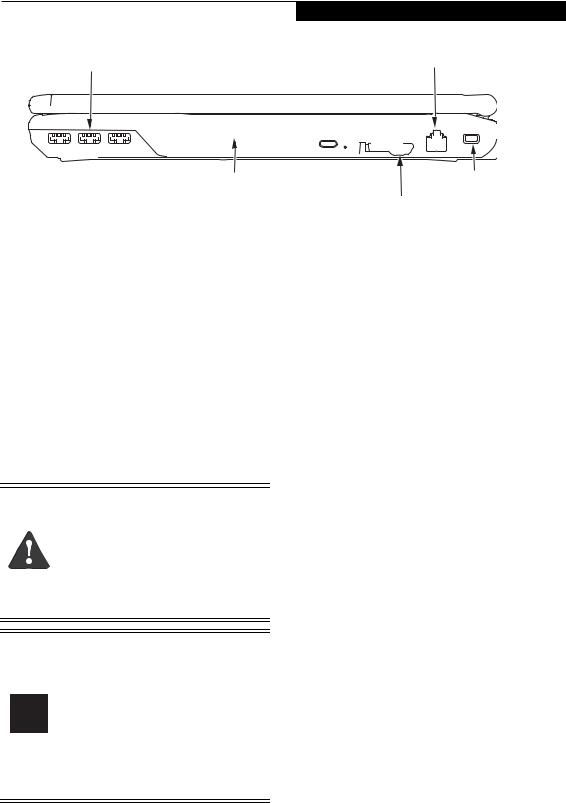
G e t t i n g t o K n o w Y o u r L i f e B o o k
|
|
|
|
USB 2.0 Ports |
|
|
|
Modem (RJ-11) Jack |
||||||||||||||||||||||||||||||
|
|
|
|
|
|
|
|
|
|
|
|
|
|
|
|
|
|
|
|
|
|
|
|
|||||||||||||||
|
|
|
|
|
|
|
|
|
|
|
|
|
|
|
|
|
|
|
|
|
|
|
|
|
|
|
|
|
|
|
|
|
|
|
|
|
|
|
|
|
|
|
|
|
|
|
|
|
|
|
|
|
|
|
|
|
|
|
|
|
|
|
|
|
|
|
|
|
|
|
|
|
|
|
|
|
|
|
|
|
|
|
|
|
|
|
|
|
|
|
|
|
|
|
|
|
|
|
|
|
|
|
|
|
|
|
|
|
|
|
|
|
|
|
|
|
|
|
|
|
|
|
|
|
|
|
|
|
|
|
|
|
|
|
|
|
|
|
|
|
|
|
|
|
|
|
|
|
|
|
|
|
|
|
|
|
|
|
|
|
|
|
|
|
|
|
|
|
|
|
|
|
|
|
|
|
|
|
|
|
|
|
|
|
|
|
|
|
|
|
|
|
|
|
|
|
|
|
|
|
|
|
|
|
|
|
|
|
|
|
|
|
|
|
|
|
|
|
|
|
|
|
|
|
|
|
|
|
|
|
|
|
|
Flexible Bay |
Anti-Theft Lock Slot |
Flexible Bay Release Latch
Figure 2-5. LifeBook notebook right-side panel
RIGHT-SIDE PANEL COMPONENTS
The following is a brief description of your LifeBook notebook’s right-side components.
USB 2.0 Ports
The USB 2.0 ports allow you to connect Universal Serial Bus devices. USB 2.0 transfers data at up to 480Mbps and is backward-compatible with USB 1.1 devices, which transfer data at up to 12Mbps. (See Universal Serial Bus Ports on page 47 for more information)
Modem (RJ-11) Telephone Jack
The Modem (RJ-11) telephone jack is for attaching a telephone line to the internal multinational 56K modem. (See Modem (RJ-11) Telephone Jack on page 46 for more information)
The internal modem is not intended for use with Digital PBX systems. Do not connect the internal modem to a Digital PBX as it may cause serious damage to the internal modem or your entire notebook. Consult your PBX manufacturer’s documentation for details. Some hotels have Digital PBX systems. Be sure to find out BEFORE you connect your modem.
The internal multinational modem is designed to the ITU-T V.90/v.92 standard. Its maximum speed of 53000 bps is the highest allowed by FCC, and its actual connection rate depends on the line conditions. The maximum speed is 33600 bps at upload, in accordance with FCC regulations.
For additional information about the modem, refer to the Fujitsu website at: us.fujitsu.com/computers.
Anti-theft Lock Slot
The anti-theft lock slot allows you to attach an optional physical lock down device.
Flexible Bay Release Latch
The Flexible Bay release latch releases the Flexible Bay device.
Flexible Bay
The Flexible Bay can accommodate one of the following devices. (See Flexible Bay Devices on page 19 for more information)
■Modular DVD-ROM drive
■Modular DVD/CD-RW combo drive
■Modular Dual-Layer Multi-Format DVD Writer
■Modular Lithium ion battery
■Modular second hard disk drive
■Weight Saver
9

L i f e B o o k E 8 0 0 0 N o t e b o o k
Parallel Port |
Gigabit LAN (RJ-45) Jack |
Figure 2-6. LifeBook notebook back panel
BACK PANEL COMPONENTS
Following is a brief description of your LifeBook notebook’s back panel components.
Parallel Port
The parallel port allows you to connect parallel devices, such as a printer. (This is also sometimes referred to as an LPT port.) (See Parallel Port on page 48 for more information)
Gigabit LAN (RJ-45) Jack
The internal LAN (RJ-45) jack is used for an internal Gigabit (10Base-T/100Base-Tx/1000Base-T) Ethernet LAN connection. (See Internal LAN (RJ-45) Jack on page 46 for more information)
10
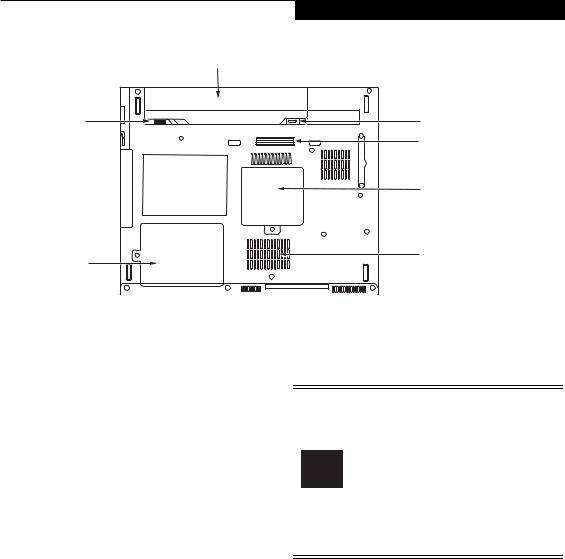
G e t t i n g t o K n o w Y o u r L i f e B o o k
Lithium ion Battery Bay
Battery Bay |
Release Button |
Battery Bay Lock
Port Replicator Connector
|
Memory Upgrade |
|
Compartment |
Hard Disk Drive |
Air Vents |
Compartment |
(various locations) |
|
Figure 2-7. LifeBook notebook bottom panel |
BOTTOM COMPONENTS
The following is a brief description of your LifeBook notebook’s bottom panel components.
Lithium ion Battery Bay
The battery bay contains the internal Lithium ion battery. It can be opened for the removal of the battery when stored over a long period of time or for swapping a discharged battery with a charged Lithium ion battery.
(See Lithium ion Battery on page 37 for more information)
Battery Bay Lock/Release Button
The battery bay lock and release button are used together to secure or remove the Lithium ion battery.
(See Replacing the Battery on page 38 for more information)
Port Replicator Connector
This connector allows you to connect the optional Port Replicator to your notebook.
Memory Upgrade Compartment
Your notebook comes with high speed Double Data Rate 2 Synchronous Dynamic RAM (DDR2 SDRAM). The memory upgrade compartment allows you to expand the system memory capacity of your notebook, thus improving overall performance. (See Memory Upgrade Module on page 44 for more information) Under normal circumstances, it should not be necessary to open this compartment.
Air Vents
The air vents allow air to circulate through the system to cool down the components.
To protect your notebook from damage and to optimize system performance, be sure to keep all air all vents unobstructed, clean, and clear of debris. This may require periodic cleaning, depending upon the environment in which the system is used.
Do not operate the notebook in areas where the air vents can be obstructed, such as in tight enclosures or on soft surfaces like a bed or cushion.
Hard Disk Drive Compartment
The hard disk drive compartment contains the hard disk drive. Under normal circumstances, it should not be necessary to open this compartment.
11
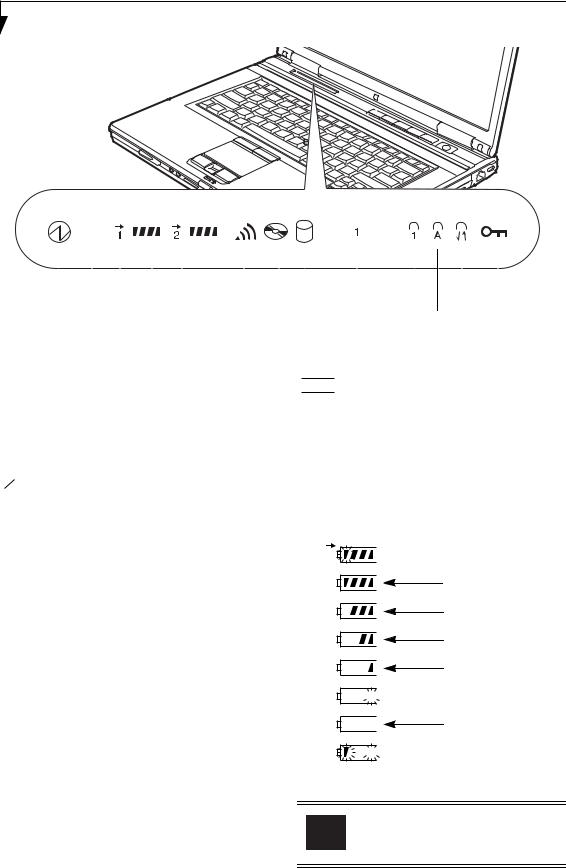
L i f e B o o k E 8 0 0 0 N o t e b o o k
|
|
|
|
|
|
|
|
|
|
|
|
|
|
|
|
|
|
|
|
|
|
|
|
|
|
|
|
|
|
|
|
|
|
|
|
|
|
|
|
|
|
|
|
|
|
|
|
|
|
|
|
|
|
|
|
|
|
|
|
|
|
|
|
|
|
|
|
|
|
|
|
|
|
|
|
|
|
|
|
|
|
|
|
|
|
|
|
|
|
|
|
|
|
|
|
|
|
|
|
|
|
|
|
|
|
|
|
|
|
|
|
|
|
|
|
|
|
|
|
|
|
|
|
|
|
|
|
|
|
|
|
|
|
|
|
|
|
|
|
|
|
|
|
|
|
|
|
|
|
|
|
|
|
|
|
|
|
|
|
|
Battery |
|
|
|
|
|
|
|
|
NumLk |
|
|
ScrLk |
|
|
||||||||||||||||
Power |
|
|
|
Battery |
|
|
|
WLAN/ |
|
Hard Drive |
|
|
|||||||||||||||||||||||||||||||||||
|
|
|
|
|
|
|
|
|
|
|
|
|
|
|
|
|
|
|
|
|
|
|
|
|
|||||||||||||||||||||||
|
|
|
|
|
|
|
|
Identifier |
|
|
Charging |
Bluetooth |
Access |
|
|
|
|
|
|
|
|
|
|
|
|
|
|
|
|
|
|
|
|
|
|||||||||||||
|
AC Adapter |
Battery |
Power |
Optical |
|
|
|
|
|
|
|
|
CapsLk |
Security |
|||||||||||||||||||||||||||||||||
|
|
|
|
|
|
|
|
|
|
|
|
|
|
Level |
|
|
|
|
|
|
|
PC Card |
|
|
|
|
|
|
|
|
|
||||||||||||||||
|
|
|
|
|
|
|
|
|
|
|
|
|
|
|
|
|
|
|
|
|
|
|
|
Drive Access |
Access (PC Card Slot) |
|
|
|
|
|
|
|
|
|
|||||||||||||
Figure 2-8. Status Indicator Panel
Status Indicator Panel
The Status Indicator displays symbols that correspond with a specific component of your Fujitsu LifeBook notebook. These symbols tell you how each of those components are operating.
 POWER INDICATOR
POWER INDICATOR
The Power indicator symbol states whether your system is operational. It has several different states, each of which tells you the mode your notebook is in.
■Steady On: This means that there is power to your LifeBook notebook and that it is ready for use.
■Flashing: This means that your notebook is in Standby mode.
■Steady Off: This means that your notebook is either in Save-to-Disk mode, or it has been turned off.
If you are charging your battery, the Power indicator will remain on even if your notebook is shut off. The Power indicator will also remain on if you have either adapter connected and are shut down from Windows.


 AC ADAPTER INDICATOR
AC ADAPTER INDICATOR
The AC Adapter indicator shows whether your notebook is operating from the AC adapter, Auto/Airline adapter or battery(s). This icon has two different states that can tell you what power source your notebook is using.
■On: This means that either of the adapters are currently in use.
■Off: Power is only coming from the batteries, and you do not have an adapter connected.


 BATTERY LEVEL INDICATORS
BATTERY LEVEL INDICATORS
The two Battery Level indicators state whether or not the primary Lithium ion battery and/or the optional second Lithium ion battery are installed (Battery 1 refers to the primary Lithium ion battery, while Battery 2 refers to the Flexible Bay optional second battery). In addition, this symbol states how much charge is available within each installed battery. The symbol will only be displayed for a battery that is currently installed in your LifeBook notebook.
 76%–100% Charging
76%–100% Charging
76%–100%
51%–75%
26%–50%
11%–25%



 Low Warning <11%
Low Warning <11%
Critical Low or
Dead Battery



 Shorted Battery
Shorted Battery
Figure 2-9 Battery Level Indicator
A shorted battery is damaged and must be replaced. (Figure 2-9)
12
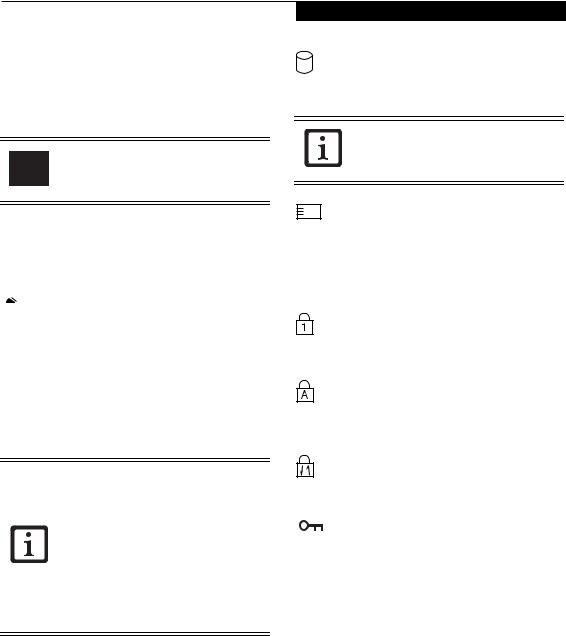
 BATTERY CHARGING INDICATORS
BATTERY CHARGING INDICATORS
Located to the left of each Battery Level indicator is a small arrow symbol. This symbol states whether that specific battery is charging. This indicator will flash if the battery is too hot or cold to charge.
Batteries subjected to shocks, vibration or extreme temperatures can be permanently damaged.
G e t t i n g t o K n o w Y o u r L i f e B o o k
HARD DRIVE ACCESS INDICATOR
The Hard Drive Access indicator shows whether your internal hard drive is being accessed.
The Hard Drive Access indicator does not show which hard drive is being accessed.

 WLAN ACCESS POWER INDICATOR
WLAN ACCESS POWER INDICATOR
The WLAN power indicator appears when the Wireless LAN or Bluetooth power is applied.
 OPTICAL DRIVE ACCESS INDICATOR
OPTICAL DRIVE ACCESS INDICATOR
The Optical Drive Access indicator tells you that the DVD/CD-RW/CD-ROM drive is being accessed. If the Auto Insert Notification function is active, the indicator will flash periodically when your system is checking the DVD/CD-RW/CD-ROM drive. If the Auto Insert Notification function is not active, the indicator will only flash when you access the DVD/CD-RW/CD-ROM drive. The default setting is the Auto Insert Notification function active.
The DVD/CD-RW/CD-ROM Auto Insert Notification function will periodically check for a DVD/CD-RW/CD-ROM installed in the drive, causing the DVD/CD-RW/CD- ROM Access indicator to flash. The DVD/ CD-RW/CD-ROM Auto Insert Notification function allows your system to start a DVD/CD-RW/CD-ROM automatically as soon as it is inserted in the drive and the tray is closed. It will begin playing an audio DVD/CD or will start an application if the DVD/CD has an auto-run file
PC CARD ACCESS INDICATOR
The PC Card Access indicator shows whether or not your notebook is accessing a PC Card. The indicator will flash if your software tries to access a PC Card even if there is no card installed. (See PC Cards/ExpressCards™ on page 42 for more information)
NUMLK INDICATOR
The NumLk indicator states that the integral keyboard is set in ten-key numeric keypad mode.
CAPSLOCK INDICATOR
The CapsLock indicator states that your keyboard is set to type in all capital letters.
SCRLK INDICATOR
The ScrLk indicator states that your scroll lock is active.
SECURITY INDICATOR
The Security Indicator flashes (if a password was set) when the system resumes from Off or Standby modes. You must enter the password that was set in the Security Panel before your system will resume operation.
13
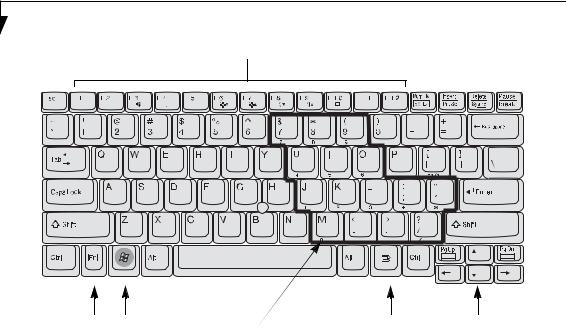
L i f e B o o k E 8 0 0 0 N o t e b o o k
Function Keys
Home |
End |
Fn Key Start Key |
Application Key |
Cursor Keys |
|
Numeric Keypad |
|
|
(surrounded by heavy line) |
|
Figure 2-10 Keyboard
Keyboard
USING THE KEYBOARD
Your Fujitsu LifeBook notebook has an integral 84-key keyboard. The keys perform all the standard functions of a 101-key keyboard, including the Windows keys and other special function keys. This section describes the following keys. (Figure 2-10)
■Numeric keypad: Your notebook allows certain keys to serve dual purposes, both as standard characters and as numeric and mathematical keys. The ability to toggle between the standard character and numerical keys is controlled through the [NumLk] key.
■Cursor keys: Your keyboard contains four arrow keys for moving the cursor or insertion point to the right, left, up, or down within windows, applications and documents.
■Function keys: The keys labeled [F1] through [F12], are used in conjunction with the [Fn] key to produce special actions that vary depending on what program is running.
■Windows keys: These keys work with your Windows operating system and function the same as the onscreen Start menu button, or the right button
on your pointing device.
NUMERIC KEYPAD
Certain keys on the keyboard perform dual functions as both standard character keys and numeric keypad keys. NumLk can be activated by pressing the [NumLk] keys. Turning off the NumLk feature is done the same way.
Once this feature is activated you can enter numerals 0 through 9, perform addition ( + ), subtraction ( - ), multiplication ( * ), or division ( / ), and enter decimal points ( . ) using the keys designated as ten-key function keys. The keys in the numeric keypad are marked on the front edge of the key to indicate their secondary functions.
(Figure 2-10)
WINDOWS KEYS
Your LifeBook notebook has two Windows keys, consisting of a Start key and an Application key. The Start key displays the Start menu. This button functions the same as your onscreen Start menu button. The Application key functions the same as your right mouse button and displays shortcut menus for the selected item. (Please refer to your Windows documentation for additional information regarding the Windows keys.)
(Figure 2-10)
CURSOR KEYS
The cursor keys are the four arrow keys on the keyboard which allow you to move the cursor up, down, left and right in applications. In programs such as Windows Explorer, it moves the “focus” (selects the next item up, down, left, or right). (Figure 2-10)
14

G e t t i n g t o K n o w Y o u r L i f e B o o k
FUNCTION KEYS
Your LifeBook notebook has 12 function keys, F1 through F12. The functions assigned to these keys differ for each application. You should refer to your software documentation to find out how these keys are used.
(Figure 2-10)
The [Fn] key provides extended functions for the notebook and is always used in conjunction with another key.
■[Fn+F3]: Pressing [F3] while holding [Fn] will toggle the Audio Mute on and off.
■[Fn+F4]: Pressing [F4] while holding [Fn] will toggle the Quick Point feature on and off. Note that the [Fn+F4] combination only works if Manual Setting is selected in the BIOS. (See Entering the BIOS Setup Utility on page 29 for more information))
■[Fn+F6]: Pressing [F6] repeatedly while holding [Fn] will lower the brightness of your display.
■[Fn+F7]: Pressing [F7] repeatedly while holding [Fn] will increase the brightness of the display.
■[Fn+F8]: Pressing [F8] repeatedly while holding [Fn] will decrease the volume of your LifeBook notebook.
■[Fn+F9]: Pressing [F9] repeatedly while holding [Fn] will increase the volume of your LifeBook notebook.
■[Fn+F10]: Pressing [F10] while holding [Fn] allows you to change your selection of where to send your display video. Each time you press the combination of keys you will step to the next choice. The choices, in order, are: built-in display panel only, both built-in display panel and external monitor or external monitor only.
15
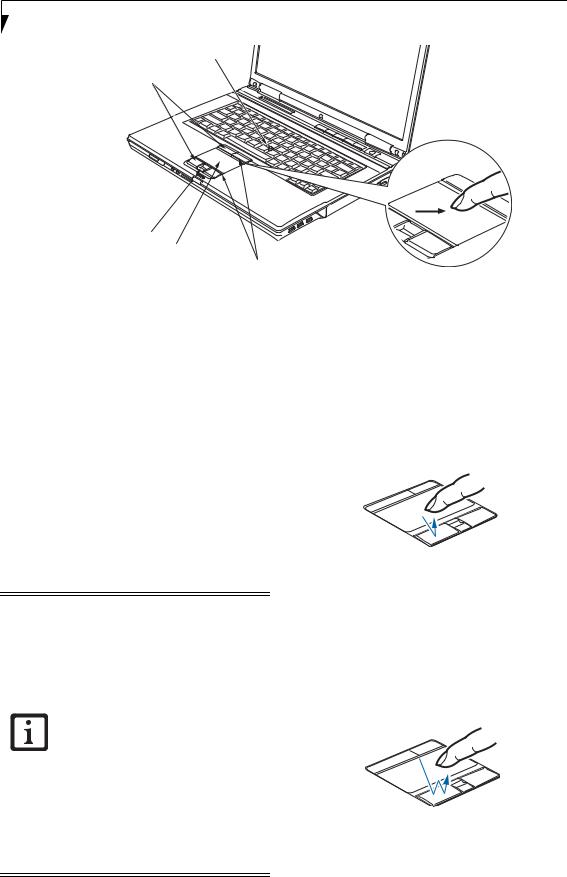
L i f e B o o k E 8 0 0 0 N o t e b o o k
Optional Quick Point Control
Left Buttons
Scroll Button or
Optional Fingerprint
Sensor
Cursor Control
Right Buttons
Figure 2-11. Touchpad pointing device
Touchpad Pointing Device
The Touchpad pointing device built into your Fujitsu LifeBook is used to control the movement of the pointer to select items on your display panel. The Touchpad is composed of a cursor control, two left and right buttons, and a scrolling button. The cursor control works the same as a mouse, and moves the cursor around the display. It only requires light pressure with the tip of your finger. The left and right buttons function the same as mouse buttons. The left and right buttons that are located at the top of the Touchpad are designed for use with the optional Quick Point Control, and they function the same as the lower buttons. The actual functionality of the buttons may vary depending on the application that is being used. The scrolling button allows you to navigate quickly through pages, without having to use the scroll bars.
■Certain E8310 LifeBooks are equipped with an optional “Quick Point” button for moving the cursor. For more about Quick Point, see “Optional Quick Point Feature” on page 17.
■The scrolling button may be replaced by an optional fingerprint sensor. To read about the fingerprint sensor, see “Fingerprint Sensor Device” on page 99.
■An external mouse can be connected to either USB or PS/2 ports on your LifeBook or the optional port replicator, and used simultaneously with the Touchpad. Note: If you boot the system with an external mouse connected the Touchpad will be disabled or enabled depending on your BIOS settings. (See Entering the BIOS Setup Utility on page 29 for more information)
CLICKING
Clicking means pushing and releasing a button. To leftclick, move the cursor to the item you wish to select, press the left button once, and then immediately release it. To right-click, move the mouse cursor to the item you wish to select, press the right button once, and then immediately release it. You also have the option to perform the clicking operation by tapping lightly on the Touchpad once. (Figure 2-12)
Figure 2-12 Clicking
DOUBLE-CLICKING
Double-clicking means pushing and releasing the left button twice in rapid succession. This procedure does not function with the right button. To double-click, move the cursor to the item you wish to select, press the left button twice, and immediately release it. You can also perform the double-click operation by tapping lightly on the Touchpad twice. (Figure 2-13)
Figure 2-13 Double-clicking
16
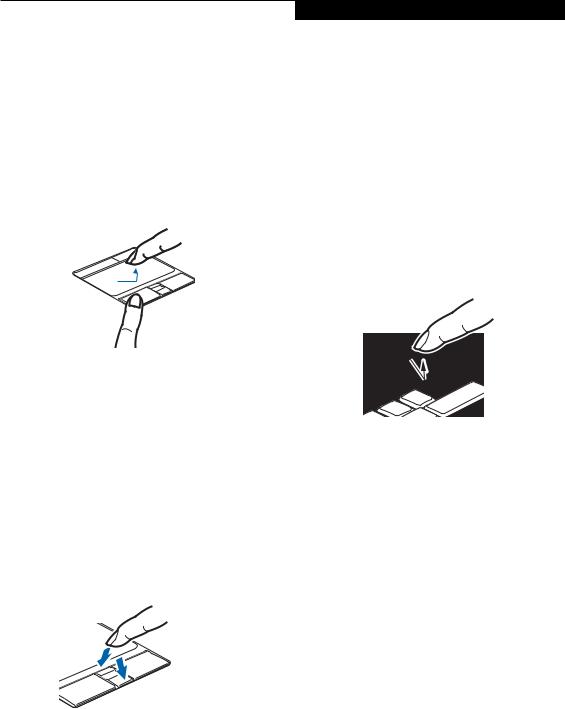
DRAGGING
Dragging means pressing and holding the left button, while moving the cursor. To drag, move the cursor to the item you wish to move. Press and hold the left button while moving the item to its new location
and then release it. Dragging can also be done using the Touchpad. First, tap the Touchpad twice over the item you wish to move making sure to leave your finger on the pad after the final tap. Next, move the object to its new location by moving your finger across the Touchpad, and then release your finger. (Figure 2-14)
Figure 2-14 Dragging
TOUCHPAD CONTROL ADJUSTMENT
The Windows Control Panel allows you to customize your Touchpad with selections made from within the Mouse Properties dialog box.
SCROLLING
Using the Scrolling button allows you to navigate through a document quickly without using the window’s scroll bars. This is particularly useful when you are navigating through on-line pages. To use the Scrolling button, press the crescent shape at the top or bottom of the button to scroll up or down a page. When you have reached the desired section of the page, release the button. (Figure 2-15)
G e t t i n g t o K n o w Y o u r L i f e B o o k
OPTIONAL QUICK POINT FEATURE
The optional Quick Point device consists of a cursor control button at the lower center of the keyboard. It is roughly the same size and shape as a pencil eraser. The cursor control works the same way a mouse ball does, and moves the cursor around the display. It only requires light pressure to move; the more pressure you use, the faster the cursor will move.
The left and right buttons that are located at the top of the Touchpad are designed for use with the Quick Point control, and they function in the same manner as the lower buttons.
When used with the Quick Point button, the middle Touchpad button allows you to scroll up and down a screen.
Figure 2-16 Using Quick Point
Figure 2-15 Scrolling
17

L i f e B o o k E 8 0 0 0 N o t e b o o k
Volume Control
Your Fujitsu LifeBook notebook has multiple volume controls which interact with each other.
Any software that contains audio files will also contain a volume control of its own. If you install an external audio device that has an independent volume control, the hardware volume control and the software volume control will interact with each other. It should be noted that if you set your software volume to Off, you will override the external volume control setting.
CONTROLLING THE VOLUME
The volume can be controlled in several different ways:
■Volume can be changed or muted from within the Volume Control on the Taskbar.
■Volume can be controlled with the F8 and F9 functions keys. Pressing [F8] repeatedly while holding [Fn] will decrease the volume of your notebook. Pressing [F9] repeatedly while holding [Fn] will increase the volume of your notebook.
■Volume can be muted by pressing the [F3] key while holding down the [Fn] key. To restore audio, repeat the [Fn+F3] procedure.
■Volume can be controlled by many volume controls that are set within individual applications.
■Certain external audio devices you might connect to your system may have hardware volume controls.
Each source discussed above puts an upper limit on the volume level that must then be followed by the other sources.
We recommend that you experiment with the various volume controls to discover the optimal sound level.
18
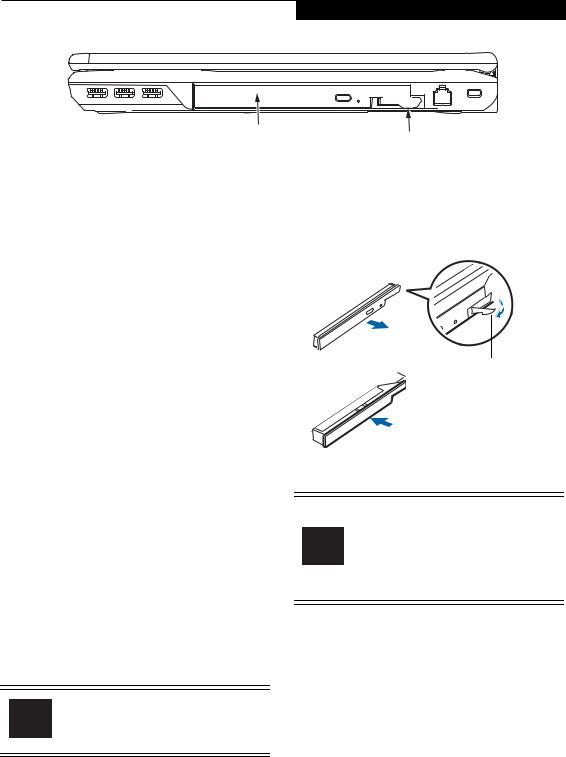
G e t t i n g t o K n o w Y o u r L i f e B o o k
Flexible Bay |
Flexible Bay Release Latch |
Figure 2-17 Flexible Bay
Flexible Bay Devices
Your notebook has a Flexible Bay that can house one of several devices. Your Flexible Bay will have one of the following devices installed.
■Modular Dual-Layer Multi-Format DVD Writer: This allows you to access movies, software, and audio DVD/CDs and record to DVD, CD, and DVD-RAM discs.
■Modular DVD/CD-RW combo drive: This allows you to access movies, software, and audio DVD/CDs as well as to write to CDs.
3.Pull out the Flexible Bay release latch. This will push your device out slightly, allowing you to remove it.
4.Slide your device out until it is clear of the bay. This will require light force.
Flexible Bay Release Latch
■Modular DVD-ROM drive: This allows you to access software, data, video, or audio discs.
■Modular Lithium ion battery: This is a rechargeable battery that can be used to power your LifeBook notebook when an adapter is not connected.
■Modular Second Hard Disk Drive: This allows you to store additional data and applications.
■Weight Saver: This is used to fill the bay when no device is needed.
REMOVING AND INSTALLING MODULAR DEVICES
There are two ways to remove and install modular devices in the Flexible Bay:
■Cold-swapping: swapping devices while your LifeBook notebook is powered off.
■Hot-swapping: swapping devices while your system is active using the Safely Remove Hardware icon from your system tray.
You should never leave your Flexible Bay empty when the notebook is in operation. If left empty, dust or foreign matter may accumulate inside the notebook.
Cold-swapping
To cold-swap modular devices in your Flexible Bay follow these easy steps: (Figure 2-18)
1.Close any open files.
2.Shut down your LifeBook notebook.
Figure 2-18 Removing/Installing a device in the Flexible Bay
Be careful when aligning and seating devices in the bay. If the fit is incorrect, you may damage the bay or the device. If the device does not move easily in the bay, remove it, and check for dirt or foreign objects. It will require a firm push to latch the device in place.
5.Slide the device you are installing into your notebook until it clicks into place.
6.It is now safe to turn your notebook back on.
7.You can now access and use the device.
Your LifeBook notebook will automatically detect the new device and activate it within your system. The drive letters associated with the device will be created and listed under My Computer and Windows Explorer.
Hot-swapping
Under Windows XP, hot-swapping is provided through the Safely Remove Hardware utility.
The icon for the utility appears on the taskbar. Click on the icon and follow the on-screen instructions.
19
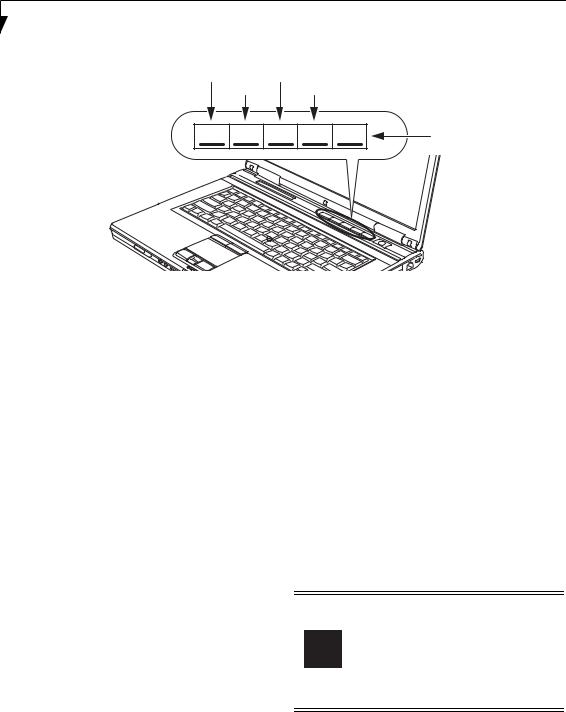
L i f e B o o k E 8 0 0 0 N o t e b o o k
Button 1 |
Button 3 |
|
|
||
Button 2 |
|
Button 4 |
|
||
1 |
2 |
3 |
4 |
Enter |
Enter button |
|
|
|
|
|
|
Figure 2-19. LifeBook Security/Application Panel
LifeBook Security/
Application Panel
A unique feature of your LifeBook notebook is the Security/Application Panel that allows you to secure your notebook from unauthorized use. The Security/Application Panel also allows you to launch applications with the touch of a button when your system is on.
If the security system is activated, upon starting your notebook or resuming from suspend mode the security system requires you to enter a password code using the buttons on the Security/Application Panel. After entering a correct password, your notebook resumes system operation. (Figure 2-19)
SETTING UP YOUR LIFEBOOK SECURITY PANEL
When you receive your LifeBook notebook, the security panel application is pre-installed without any passwords. The following sections provide detailed information on your security panel, and how to set, change or remove passwords.
Numbered Buttons
Use these buttons to enter your password.
Enter Button
After entering the button strokes, push this button to enter the password into the LifeBook notebook.
PASSWORDS
The user and supervisor password may be set on this notebook. A supervisor password is typically the same for all LifeBook notebooks in a working group, office, or company to allow for system management. Individual LifeBook notebooks in a group environment should not use a common password. A password consists of one to five button strokes plus the [Enter] button. A valid
stroke consists of pushing one or up to four buttons simultaneously. The following are valid button strokes:
■Pushing [4] by itself
■Pushing [2] and [3] at the same time
■Pushing [1], [2], and [4] at the same time
■Pushing [1], [2], [3], and [4] at the same time
The following are valid passwords. The numbers within braces ({ }) are button strokes using more than one button.
■{[2]+[3]}, [1], [enter]
■[4], [enter]
■{[1]+[3]}, {[2]+[3]+[4]}, [1], [4], [2], [enter]
Setting Passwords
When shipped from the factory, no passwords are set. You have a choice of having no password or setting a supervisor and user password. You must set the supervisor password before the user password.
The purpose of supervisor password is to be able to bypass the user password in case the user password is forgotten. The supervisor password alone will not lock the system.
You must set both the supervisor and user passwords for the security panel to work.
Setting Supervisor Password
You must have set a supervisor password before setting any user passwords. The supervisor password can bypass the user password. Depending upon your operating system, use the appropriate procedure below.
Windows XP:
1.Go to the Start menu.
2.Click on Run.
20
